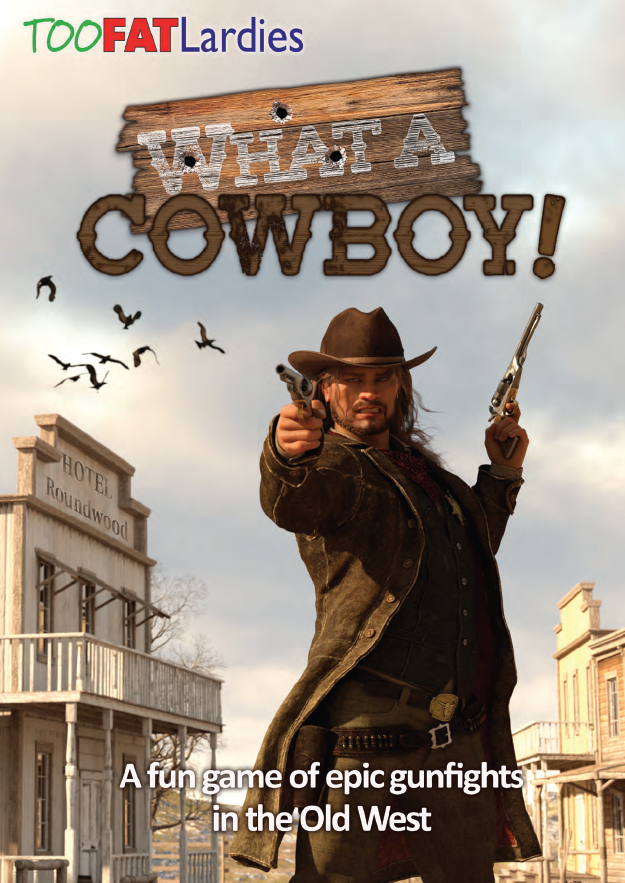Recently released at Salute, What a Cowboy is the latest ruleset from Goon-favorite rules company TooFatLardies. It’s a gunfight game set in the Old West using the What A Tanker! engine modified for cowboys. We’re going to have a more in-depth review once the physical copies arrive from Blighty, but first we’uns wanted to share some initial impressions with you hoopleheads just wallowing in the thoroughfare. As usual, we’re excited about a new TFL release and wanted to get going on game coverage. We have not played the game thoroughly yet – these are strictly the first things that came to mind after giving it a thorough readthrough.
To grab a copy for yourself head over to TooFatLardies website. To supplement our own first impressions, we encourage you to check out what the videos TFL have also published on how to play, including a full on battle report style video here. Cast Dice podcast guy Brad also had a lengthy in-depth convo with Rich and John here. What a Cowboy is based on the What A Tanker engine – you can find our review here.
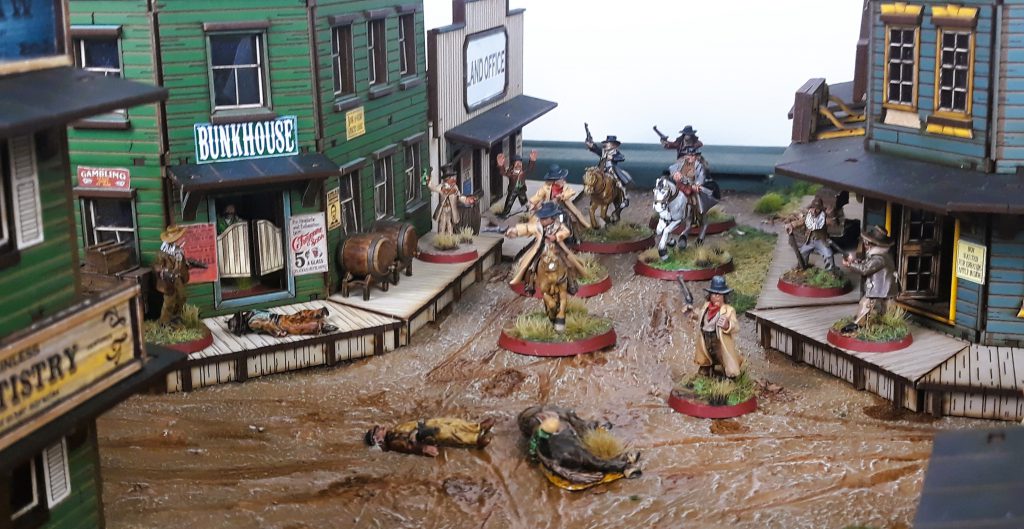
What is your initial first impression of the ruleset?
Alex: It’s impossible to avoid comparing What A Cowboy against the other Wild West rulesets that have come out in recent years. Personally, my point of comparison is Dracula’s America by Osprey Publishing, which allows for both historical and supernatural Wild West skirmishes and is a favorite beer-and-pretzel game at my club.
Overall, my first impression was that there wasn’t a ton I hadn’t seen before in other Wild West wargames. There is, of course, an obligatory poker card activation system. Dollars are used to recruit and equip your gang. In campaign games your characters amass reputation and funds from their games to level up. This is all pretty standard Wild West stuff.
What I think it does offer, though, are more interesting and dynamic gunfights which, well, is what we’re all here for isn’t it?

HardyRoach: Good! I think TFL have a talent for getting at the heart of periods and really effectively evoking the feel of them. WAC really seems to showcase the essence of the Wild West myth – unique characters, mechanics which emphasize both skill and luck, and the tension before the shooting starts. A lot of the particulars, as Alex said, are familiar to anyone who’s read a Wild West game before.
Michael O “Mugginns”: I’ve been waiting for this one for a while. It is a modification of What a Tanker, a previous TooFatLardies ruleset, and I just wasn’t sure how well it’d work going from tanks to single model guys. Using a bunch of dice to represent different parts of a tank – the pieces but also the crew felt right – I just wasn’t sure if that’d translate to a single guy.
Good news – my first read through is very encouraging and my fears are gone. WAC is full of a lot of narrative support that we’re used to with TFL games. The mechanics also work well for pushing cowboys around the board blasting away – spotting may be new to some players but does, in my mind, work – because we’ve all seen the movies where bushwhackers hide in the bushes, or the hero hides behind his last piece of cover between him and the evil posse. There are a lot of cinematic rules in here you’d expect – like falling, dodging, reloading, riding horses, etc. In particular, I really like the idea of the Bonanza mechanic that allows you to do special actions.
I think this will be something great for groups of players each having 2-4 guys and fighting on a 4×4 table. There are a lot of Wild West rulesets out there, and a lot of them are set up for that, but many are a little too much on the ‘fast play roll dice’ side for me, and many are out of print. The Henchmen and Townsfolk rules will add a lot of spice and flavor to the games we play, something that I think is huge in TFL games but not always easy to implement as you’re just trying to teach the mechanics of the rules sometimes. I think this is easily a differentiator for the game.

What do you think of the layout, design, and organization?
Alex: I see this as a rule book written by wargamers, for wargamers – by which I mean it assumes knowledge of a certain amount of conventions, and while I was able to imply how certain things worked, they could be spelled out more explicitly.
For example, what a Turn is and how it operates is not put together for the reader. On one page Character Cards are introduced, on another page are instructions to form the Game Deck (sometimes also referred to as the Activation Deck) using the Character Cards, and finally in the glossary a Turn is defined as one cycle through the Game Deck. Only once the reader has assembled these three pieces can they be sure about how to play a Turn. I think an entire sample turn given as an example would have been very helpful to include. (Editors note: you can find a game turn example in the video here)
Graphically, I think the rulebook is pleasant to look at. It has plenty of pictures and a few diagrams to illustrate certain concepts. Most pages aren’t walls of text (a particular pet peeve of mine). However, I was a bit leery of the abundance of Game Terms. In a particular two-page section you’re introduced to Force Morale, Character Morale (is this the same as Force Morale?), Character Points, Character Level, and a Ride or Die Rating for your gang. Was there no way to combine some of these and simplify things for your readers?

HardyRoach: Yeah agreed. I found myself leafing through the book to remind myself just what the hell this particular proper noun was referring to. But other than that the book is quite pretty. Nice art, good diagrams, decent if basic layout. The addition of a QRF at the back would have been nice, as it is for any game, but the community has likely already made one.
A specific complaint I have is there’s not a whole lot of clarity between what rules apply in campaign games and which apply in pick-ups. For instance, characters are listed as starting with a Colt .45 and a stock horse by default, but it’s not altogether clear whether this applies to just campaign gangs or not. It’s also not clear whether the restrictions on which weapon lists characters can draw from also apply in pick-up games.
Michael O “Mugginns”: Overall I think for anyone who is used to TFL or historical games in general, you’ll be familiar with the layout style. I do like the Glossary right at the front – we’ve needed Glossaries in TFL books in the past and it helps a lot here. I like the inclusion of the art – it’s very much of the period and draws a lot from the movies and stories we’re all familiar with.
TFL has done a great job upping their design ability from early stuff like Sharp Practice 1.0 to where they are today – lots of great illustrated examples of gameplay and rules interactions. Like What a Tanker!, the rules go through the different actions you can do with each die, so that is a natural progression. I honestly cannot wait to start the campaign – it looks like it’ll be a lot of fun and be ripe for a lot of extra supplemental stuff.
I would really like a QRS with the tables and things – ranges of weapons, horse reactions, random events, etc. I know one will be out shortly. I’d also really love it if I could easily get dice with the actions on them, instead of numbers, because when I run con games I know it’ll come up a lot.
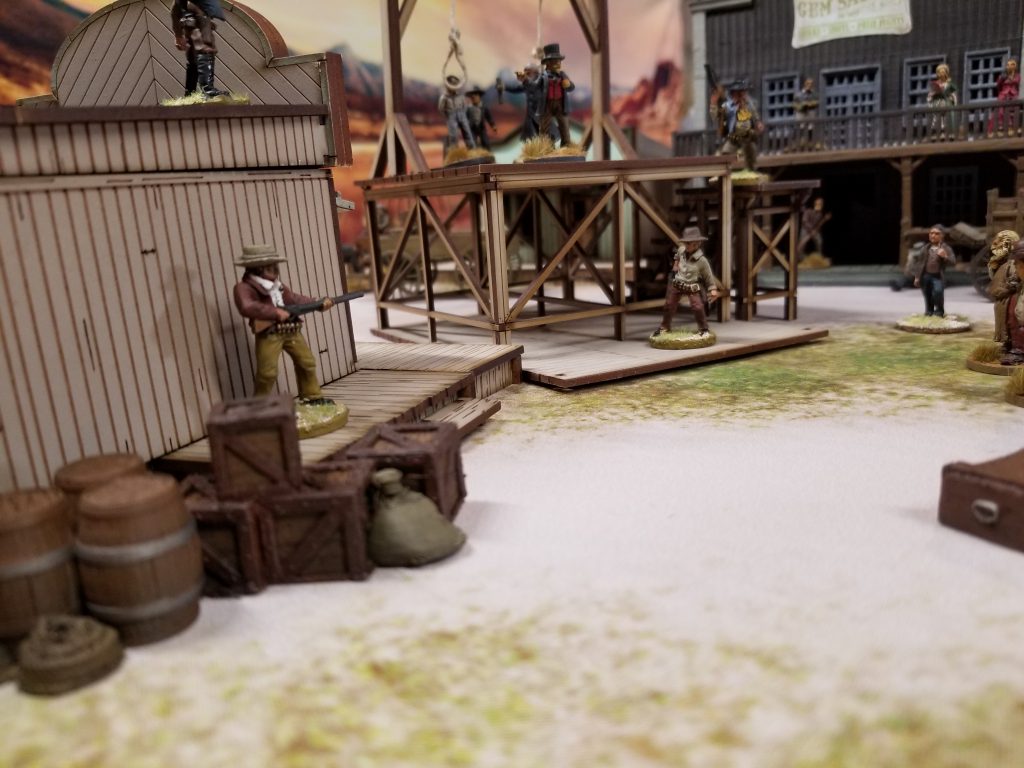
What do you think of the complexity of the ruleset?
Alex: Generally I’m the one who has to teach others how to play a ruleset so, for my own sanity, I generally prefer rules that are fast-playing and don’t require players to reference the rulebook constantly. This isn’t to say that What a Cowboy is especially complex, but it does have a certain level of granularity to it. However, I don’t see that as a bad thing in this case.
Considering the very small number of models involved (the rules recommend 2-6 per player) I think the granularity sets it apart from some of the other Wild West rulesets that abstract certain things away. For example, I like that ammo is tracked for each gun and that you have to use a reload dice to eject each spent shell and load a new one in. I also like that models sustain wounds to specific body parts that cripple them in various ways. The action dice system, of course, is the star of the show and provides an interesting source of friction and player decision each turn.
On the hand, there are some aspects I’m not as thrilled about. There seems to be a need for several types of tokens to track whether or not a model has has aimed, is spotted, or if they’re pinned. Lastly, the ever-present tables of Lardy games make their appearance on many pages of the rulebook, requiring the players to reference the rulebook frequently. (Editors note: a QRS produced by TFL has been released to help out with this)
HardyRoach: While there’s a fair amount of granularity to the rules, I feel like they’re decently covered by a good QRF, so I’m not too worried about running it for new people. I love the tactile quality of tracking ammo (particularly as someone made an amazing 3D printable dashboard with realistic ammo cylinders/breaches that can be chambered with bullets and shells), and the level of detail and variation in wounds and character reactions really adds to the narrative experience. I agree with Alex that the number of counters seems a little much. Also, this is a tertiary complaint, but I suspect the gentleman who write for TFL may not have noticed that the Bonanza tokens have the Bitcoin logo on them.
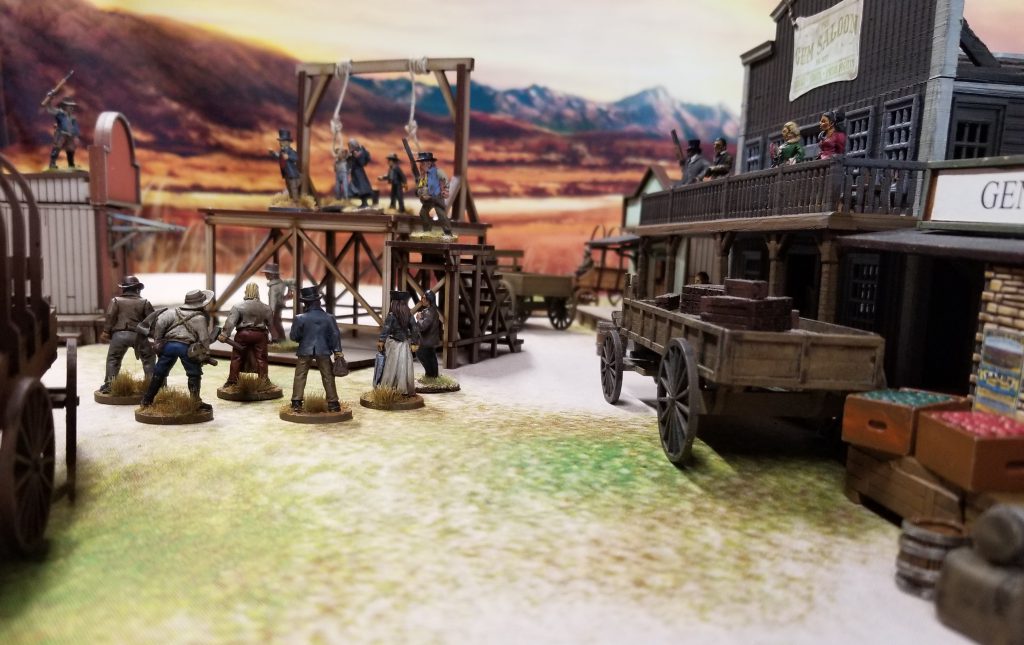
Michael O “Mugginns”: As I said before, the Wild West ruleset landscape is populated heavily with a lot of ‘fast play’ rules that are basically like Uno for wargames for me. While there are a few I enjoy – particularly Gunfighter’s Ball – I’m glad to see another come up to the plate that isn’t just move/shoot/fight.
I like that the author included rules for stunts, trick shots, and random events. These are a little added complexity but will add a lot of flavor to the game. Similarly, Bonanza is a resource management mechanic that allows you to push your cowboys a bit further when you need it – more complexity but an additional layer to the game that really goes far.
I actually really 100% do like having tokens in my games. Having come from a background where I’ve played a lot of competitive games where you need to keep track of board stuff, I don’t mind getting together some tokens to track things. I have a whole box of them for Sharp Practice and in my opinion, it helps keep the game flowing especially if you’re playing with new people.
I would like to have seen more missions included, but I think we’ll see those in the future. Pre-written characters would be lovely as well, with ready to go campaign hooks etc.
The last bit of our initial impression is to make a gang using the rules on p50 with $150.. Our setting is 1875 in Arizona.
The Wild Wolverines
Made up of Union veterans from Michigan who marched with the Wide Awakes to support Honest Abe of the West, The Wild Wolverines have fallen on hard times. While they adore President Grant, they lost their livelihoods in the Panic of 1873 and have resorted to robbing banks, trains, wagons, and passersby to make ends meet. When they can, they help out old vets in town and freedmen with a few extra dollars here and there. They take jobs to take down cruel land barons who are looking for nothing more than gold in their pocket at the expense of all others.
Jim Oscoda, The Stone Cold Killer from Kalamazoo
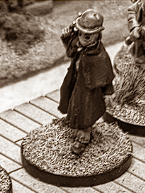
Gunslinger Background: Frontier Scout Skills/Notes: Stealthy Primary Weapon: Colt Navy Revolver Secondary Weapon: Musket Cost: $65
Bill Genesee, Who Shot Bob Toledo In The Back
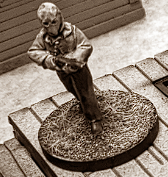
Shootist Background: Soldier Skills/Notes: None Primary Weapon: Shotgun Cost: $60
John Kalkaska, The Coward
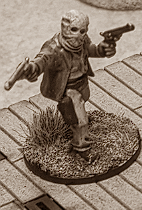
Greenhorn Background: Homesteader Skills/Notes: Jumpy Primary Weapon: Colt Navy Revolver Cost: $25
The Collins Gang
The eldest Collins brother, Theo, was gunned down in a Jerome, AZ saloon during a card game dispute. As the new head of the Collins family, Frank gathered the loyal cowhands from his ranch and rode to the town, seeking revenge. Frank ambushed the suspected culprit outside of his home and gunned him down in plain sight of the town. Soon after, a warrant was put out for his arrest and he fled to the hills with a few remaining followers. Since then Frank and his gang have survived by raiding the mines and ranches around Jerome, somehow staying one step ahead of the law.
Frank ‘The Tank’ Collins
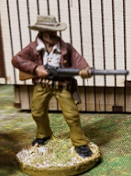
Shootist Background: Soldier Skills/Notes: Brawler Primary Weapon: Shotgun Secondary Weapon: Knife Cost: $65
Henry ‘Deadeye’ Jenkins
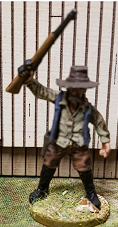
Shootist Background: Buffalo Hunter Skills/Notes: Deadeye Primary Weapon: Springfield Carbine Cost: $60
Wiley Pete
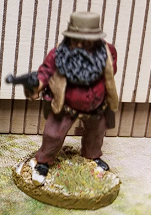
Greenhorn Background: Miner Skills/Notes: Tough Primary Weapon: Colt Navy Revolver Cost: $25
The Reeves Posse
Fredrick Reeves was born into slavery on the Dotson plantation near Hope, Arkansas. When the Civil War broke out, he was dragged along to serve as a servant for Albert Dotson, the scion of the family whose family connections had earned him the rank of Captain. A drunken incompetent, the young Dotson swiftly brought his unit to ruin, and Reeves took the opportunity to put a bullet between his eyes and escape north. After the war, Reeves’ grit and keen eye led him towards bounty hunting, where he excelled. After taking out the remnants of Quantrill’s raiders, he was officially sworn in as a US Marshall. As a favor to his sister he deputized his two nephews, Jamie and Eli Samuels, in the hope that they might find an honest trade.
Fredrick “Fox” Reeves, US Marshall
Legend Background: Bounty Hunter Skills/Notes: Lightning Fast, Tough Primary Weapon: Colt .45 Cost: $80
Jamie Samuels
Greenhorn Background: Homesteader Skills/Notes: None Primary Weapon: Shotgun $50
Eli Samuels
Greenhorn Background: Townsperson Skills/Notes: None Primary Weapon: Pepperbox Pistol $20
This is just the beginning of our coverage of What a Cowboy – check back later for a full in-depth review!
